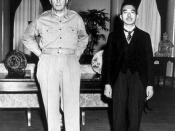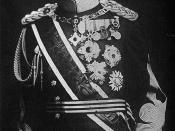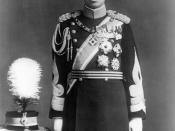The 20th century was by all accounts an era of considerable progress for Japan. As a result of the remarkable success in the postwar era, Japan has become a model of the industrialized society for the world to take note. In this paper I will attempt to illustrate the important changes that Japan went through during this time of progression, using 1945 as a dividing point. These changes include a different role of the emperor, a new political system, social reform and the rise and downfall of the economy.
Emperor Hirohito (1901-1989) was the emperor of Japan from 1926 to 1989. He chose to designate his reign with the term "Showa" (Enlightened Peace) and he is sometimes referred to as the Emperor Showa. His reign was the longest of any monarch in Japanese history.
Under the Japanese political system before World War II, the Emperor was in theory all-powerful.
The emperor was sovereign, and everyone who worked for the government in effect worked for the Emperor. That meant, in effect, that power was divided among several different groups within the Japanese political system, most importantly, the military, the civilian bureaucracy, and to some extent the Diet, the Japanese parliament.
In the pre-war period, before the Second World War, the fact that the Emperor was in theory all-powerful meant in effect that those groups who could claim to speak for the Emperor were the ones who were in fact all-powerful. So that we know in the 1930s it was the Japanese military, which claimed to speak on behalf of the Emperor, which managed to secure virtually all political power unto itself.
After the Japanese surrendered at the end of World War II in 1945, American forces under Gen. Douglas MacArthur occupied Japan until 1952. During this occupation Japan was forced...


